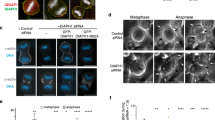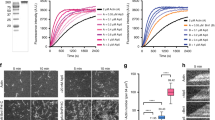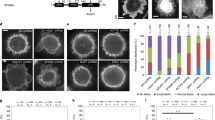Abstract
Formins are conserved Rho-GTPase effectors that communicate Rho-GTPase signals to the cytoskeleton. We found that formins were required for the assembly of one of the three budding yeast actin structures: polarized arrays of actin cables. A dominant-active formin induced the assembly of actin cables. The activation and localization of the formin Bni1p required components of the polarisome complex. These findings potentially define the cellular function of formins in budding yeast and explain their involvement in the generation of cell polarity. A requirement for formins in constructing specific actin structures might be the basis for the diverse activities of formins in development.
This is a preview of subscription content, access via your institution
Access options
Subscribe to this journal
Receive 12 print issues and online access
$209.00 per year
only $17.42 per issue
Buy this article
- Purchase on Springer Link
- Instant access to full article PDF
Prices may be subject to local taxes which are calculated during checkout








Similar content being viewed by others
References
Drubin, D. G. & Nelson, W. J. Origins of cell polarity. Cell 84, 335–344 (1996).
Hall, A. Rho GTPases and the actin cytoskeleton. Science 279, 509–514 (1998).
Pruyne, D. & Bretscher, A. Polarization of cell growth in yeast. II. The role of the cortical actin cytoskeleton. J. Cell Sci. 113, 571–585 (2000).
Pruyne, D. & Bretscher, A. Polarization of cell growth in yeast. I. Establishment and maintenance of polarity states. J. Cell Sci. 113, 365–375 (2000).
Frazier, J. A. & Field, C. M. Actin cytoskeleton: are FH proteins local organizers? Curr. Biol. 7, R414–R417 (1997).
Mass, R. L., Zeller, R., Woychik, R. P., Vogt, T. F. & Leder, P. Disruption of formin-encoding transcripts in two mutant limb deformity alleles. Nature 346, 853–855 (1990).
Tanaka, K. Formin family proteins in cytoskeletal control. Biochem. Biophys. Res. Commun. 267, 479–481 (2000).
Alberts, A. S. Identification of a carboxyl-terminal diaphanous-related formin homology protein autoregulatory domain. J. Biol. Chem. 276, 2824–2830 (2001).
Watanabe, N., Kato, T., Fujita, A., Ishizaki, T. & Narumiya, S. Cooperation between mDia1 and ROCK in Rho-induced actin reorganization. Nature Cell Biol. 1, 136–143 (1999).
Nakano, K. et al. Distinct actions and cooperative roles of ROCK and mDia in Rho small G protein-induced reorganization of the actin cytoskeleton in Madin-Darby canine kidney cells. Mol. Biol. Cell 10, 2481–2491 (1999).
Tominaga, T. et al. Diaphanous-related formins bridge Rho GTPase and Src tyrosine kinase signaling. Mol. Cell 5, 13–25 (2000).
Ishizaki, T. et al. Coordination of microtubules and the actin cytoskeleton by the Rho effector mDia1. Nature Cell Biol. 3, 8–14 (2001).
Kato, T. et al. Localization of a mammalian homolog of diaphanous, mDia1, to the mitotic spindle in HeLa cells. J. Cell Sci. 114, 775–784 (2001).
Palazzo, A. F., Cook, T. A., Alberts, A. S. & Gundersen, G. G. mDia mediates Rho-regulated formation and orientation of stable microtubules. Nature Cell Biol. 3, 723–729 (2001).
Chang, F. Movement of a cytokinesis factor cdc12p to the site of cell division. Curr. Biol. 9, 849–852 (1999).
Kamei, T. et al. Interaction of Bnr1p with a novel Src homology 3 domain-containing Hof1p. Implication in cytokinesis in Saccharomyces cerevisiae. J. Biol. Chem. 273, 28341–28345 (1998).
Ozaki-Kuroda, K. et al. Dynamic localization and function of Bni1p at the sites of directed growth in Saccharomyces cerevisiae. Mol. Cell. Biol. 21, 827–839 (2001).
Vallen, E. A., Caviston, J. & Bi, E. Roles of Hof1p, Bni1p, Bnr1p, and Myo1p in cytokinesis in Saccharomyces cerevisiae. Mol. Biol. Cell 11, 593–611 (2000).
Evangelista, M. et al. Bni1p, a yeast formin linking Cdc42p and the actin cytoskeleton during polarized morphogenesis. Science 276, 118–122 (1997).
Imamura, H. et al. Bni1p and Bnr1p: downstream targets of the Rho family small G-proteins which interact with profilin and regulate actin cytoskeleton in Saccharomyces cerevisiae. EMBO J. 16, 2745–2755 (1997).
Kohno, H. et al. Bni1p implicated in cytoskeletal control is a putative target of Rho1p small GTP binding protein in Saccharomyces cerevisiae. EMBO J. 15, 6060–6068 (1996).
Fujiwara, T., Tanaka, K., Inoue, E., Kikyo, M. & Takai, Y. Bni1p regulates microtubule-dependent nuclear migration through the actin cytoskeleton in Saccharomyces cerevisiae. Mol. Cell. Biol. 19, 8016–8027 (1999).
Lee, L., Klee, S. K., Evangelista, M., Boone, C. & Pellman, D. Control of mitotic spindle position by the Saccharomyces cerevisiae formin Bni1p. J. Cell Biol. 144, 947–961 (1999).
Miller, R. K., Matheos, D. & Rose, M. D. The cortical localization of the microtubule orientation protein, Kar9p, is dependent upon actin and proteins required for polarization. J. Cell Biol. 144, 963–975 (1999).
Schuyler, S. C. & Pellman, D. Search, capture and signal: games microtubules and centrosomes play. J. Cell Sci. 114, 247–255 (2001).
Theesfeld, C. L., Irazoqui, J. E., Bloom, K. & Lew, D. J. The role of actin in spindle orientation changes during the Saccharomyces cerevisiae cell cycle. J. Cell Biol. 146, 1019–1032 (1999).
Miller, R. K. & Rose, M. D. Kar9p is a novel cortical protein required for cytoplasmic microtubule orientation in yeast. J. Cell Biol. 140, 377–390 (1998).
Korinek, W. S., Copeland, M. J., Chaudhuri, A. & Chant, J. Molecular linkage underlying microtubule orientation toward cortical sites in yeast. Science 287, 2257–2259 (2000).
Lee, L. et al. Positioning of the mitotic spindle by a cortical-microtubule capture mechanism. Science 287, 2260–2262 (2000).
Miller, R. K., Cheng, S. C. & Rose, M. D. Bim1p/Yeb1p mediates the Kar9p-dependent cortical attachment of cytoplasmic microtubules. Mol. Biol. Cell 11, 2949–2959 (2000).
Beach, D. L., Thibodeaux, J., Maddox, P., Yeh, E. & Bloom, K. The role of the proteins Kar9 and Myo2 in orienting the mitotic spindle of budding yeast. Curr. Biol. 10, 1497–1506 (2000).
Yin, H., Pruyne, D., Huffaker, T. C. & Bretscher, A. Myosin V orientates the mitotic spindle in yeast. Nature 406, 1013–1015 (2000).
Sheu, Y. J., Santos, B., Fortin, N., Costigan, C. & Snyder, M. Spa2p interacts with cell polarity proteins and signaling components involved in yeast cell morphogenesis. Mol. Cell. Biol. 18, 4053–4069 (1998).
Pruyne, D. W., Schott, D. H. & Bretscher, A. Tropomyosin-containing actin cables direct the Myo2p-dependent polarized delivery of secretory vesicles in budding yeast. J. Cell Biol. 143, 1931–1945 (1998).
Karpova, T. S., McNally, J. G., Moltz, S. L. & Cooper, J. A. Assembly and function of the actin cytoskeleton of yeast: relationships between cables and patches. J. Cell Biol. 142, 1501–1517 (1998).
Doyle, T. & Botstein, D. Movement of yeast cortical actin cytoskeleton visualized in vivo. Proc. Natl Acad. Sci. USA 93, 3886–3891 (1996).
Madania, A. et al. The Saccharomyces cerevisiae homologue of human Wiskott–Aldrich syndrome protein Las17p interacts with the Arp2/3 complex. Mol. Biol. Cell 10, 3521–3538 (1999).
Winter, D., Lechler, T. & Li, R. Activation of the yeast Arp2/3 complex by Bee1p, a WASP-family protein. Curr. Biol. 9, 501–504 (1999).
Ayscough, K. R. et al. High rates of actin filament turnover in budding yeast and roles for actin in establishment and maintenance of cell polarity revealed using the actin inhibitor latrunculin-A. J. Cell Biol. 137, 399–416 (1997).
Fujiwara, T. et al. Rho1p–Bni1p–Spa2p interactions: implication in localization of Bni1p at the bud site and regulation of the actin cytoskeleton in Saccharomyces cerevisiae. Mol. Biol. Cell 9, 1221–1233 (1998).
Amberg, D. C., Zahner, J. E., Mulholland, J. W., Pringle, J. R. & Botstein, D. Aip3p/Bud6p, a yeast actin-interacting protein that is involved in morphogenesis and the selection of bipolar budding sites. Mol. Biol. Cell 8, 729–753 (1997).
Zahner, J. E., Harkins, H. A. & Pringle, J. R. Genetic analysis of the bipolar pattern of bud site selection in the yeast Saccharomyces cerevisiae. Mol. Cell. Biol. 16, 1857–1870 (1996).
Machesky, L. M. & Hall, A. Role of actin polymerization and adhesion to extracellular matrix in Rac- and Rho-induced cytoskeletal reorganization. J. Cell Biol. 138, 913–926 (1997).
Kim, A. S., Kakalis, L. T., Abdul-Manan, N., Liu, G. A. & Rosen, M. K. Autoinhibition and activation mechanisms of the Wiskott–Aldrich syndrome protein. Nature 404, 151–158 (2000).
Rohatgi, R. et al. The interaction between N-WASP and the Arp2/3 complex links Cdc42-dependent signals to actin assembly. Cell 97, 221–231 (1999).
Winter, D., Podtelejnikov, A. V., Mann, M. & Li, R. The complex containing actin-related proteins Arp2 and Arp3 is required for the motility and integrity of yeast actin patches. Curr. Biol. 7, 519–529 (1997).
Winter, D. C., Choe, E. Y. & Li, R. Genetic dissection of the budding yeast Arp2/3 complex: a comparison of the in vivo and structural roles of individual subunits. Proc. Natl Acad. Sci. USA 96, 7288–7293 (1999).
Lynch, E. D. et al. Nonsyndromic deafness DFNA1 associated with mutation of a human homolog of the Drosophila gene diaphanous. Science 278, 1315–1318 (1997).
Acknowledgements
We thank D. C. Amberg, D. Botstein, A. Bretscher, T. Lechler, R. Li, K. Ozaki-Kuroda, D. Pruyne, Y. Takai and B. Winsor for strains and/or reagents; J. D. Cande, B. Goode, M. E. McLaughlin, A. Rodal, S. C. Schuyler, R. Segal and B. Sheeman for reading the manuscript; B. Goode, A. Rodal and members of the Pellman laboratory for discussions; J. Liu and S. Randall for assistance and advice on microscopy; and F. Chang and C. Boone for communicating unpublished results. D.P. was supported by NIH GM61345 and a Scholar Award from the Leukemia and Lymphoma Society of America.
Author information
Authors and Affiliations
Corresponding author
Rights and permissions
About this article
Cite this article
Sagot, I., Klee, S. & Pellman, D. Yeast formins regulate cell polarity by controlling the assembly of actin cables. Nat Cell Biol 4, 42–50 (2002). https://doi.org/10.1038/ncb719
Received:
Revised:
Accepted:
Published:
Issue Date:
DOI: https://doi.org/10.1038/ncb719
This article is cited by
-
Designer membraneless organelles sequester native factors for control of cell behavior
Nature Chemical Biology (2021)
-
Roles of the PH, coiled-coil and SAM domains of the yeast polarity protein Boi2 in polarity-site localization and function in polarized growth
Current Genetics (2020)
-
Implications of maintenance of mother–bud neck size in diverse vital processes of Saccharomyces cerevisiae
Current Genetics (2019)
-
Structural basis of actin monomer re-charging by cyclase-associated protein
Nature Communications (2018)
-
Lack of Diaph3 relaxes the spindle checkpoint causing the loss of neural progenitors
Nature Communications (2016)



